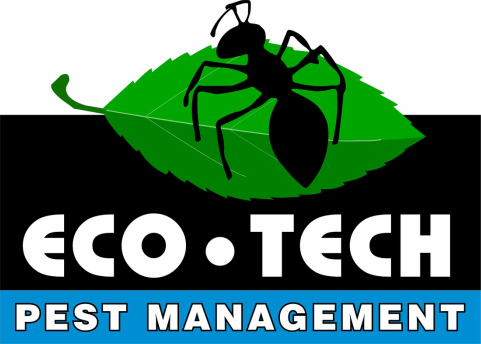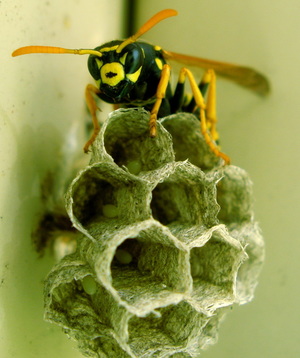Paper Wasp Control
Our Solution
Paper wasps can be quite aggressive and eliminating an entire nest of them is more than most homeowners care to tackle. We at Eco-Tech provide fast, safe paper wasp elimination. Unlike most treatments, which can only be done at night when the entire colony is inside the nest, our treatment can be done at any time. This allows us to schedule services when it is convenient for you and eliminates the need for costly after-hours charges. All of our state-certified technicians come equipped with a fully protective bee suit which allows them to get up close to the nest and treat it thoroughly without having to worry about being attacked. Safety and environmentally responsible practices are top priorities for our company. We only use EPA registered products and apply them with the safety of your family and pets in mind. As with all of our services, our paper wasp treatments are backed by our written guarantee.
Paper Wasp Information
Description: Paper wasps are between ¾ and 1 inch long and are thin-waisted. There are 22 identified species of Polistes paper wasps in North America and coloration can vary between them. They can come in varying combinations of reddish-brown, brown, black and yellow.
Nest: As their name would imply, paper wasps make their nests out of paper which they produce by chewing up wood and plant stems and mixing it with their saliva. Their nests differ from that of other stinging insects in that they are formed in the shape of an upside down umbrella and have no paper cover to protect the cells. Paper wasps build their nests in protected areas such as under eaves, behind shutters, and in dense vegetation. The nest is abandoned in the fall and will not be reused the following year.
Sting: Although paper wasps tend to be slightly less aggressive than bald-faced hornets and yellow jackets, they will still defend their nest if threatened and are capable of stinging multiple times. Most people only experience localized pain, itching, redness, and swelling when stung, but people who are allergic can have more severe and even life-threatening reactions. You should seek emergency medical attention if you experience any of the following symptoms – abnormal breathing, tightness in chest or throat, dizziness, fainting, hives, nausea or vomiting.
Life Cycle: Each year, fertilized queens from the previous year emerge from their winter shelters. The queen begins to construct a small nest in which to lay her eggs. The nest contains individual cells and a single egg is laid in each one. The eggs soon hatch into grub-like larvae which are fed and cared for by the queen. When the larvae are fully grown they spin silk cocoons inside their cells in which they pupate. They emerge as sterile female workers which take over nest-building and foraging for the queen. In the late summer the female workers start to develop into queens at which time the queen begins to lay unfertilized eggs that develop into males. The males are unable to sting and their only purpose is to fertilize the newly developed queens. In the fall all of the males die off. The only members of the colony that survive are the queens which leave the nest to find a safe place to spend the winter. Each queen will start a new nest the following spring. A typical paper wasp nest consists of 20 to 30 individuals.
Diet: Paper wasps eat nectar, pollen, and other insects.
Nest: As their name would imply, paper wasps make their nests out of paper which they produce by chewing up wood and plant stems and mixing it with their saliva. Their nests differ from that of other stinging insects in that they are formed in the shape of an upside down umbrella and have no paper cover to protect the cells. Paper wasps build their nests in protected areas such as under eaves, behind shutters, and in dense vegetation. The nest is abandoned in the fall and will not be reused the following year.
Sting: Although paper wasps tend to be slightly less aggressive than bald-faced hornets and yellow jackets, they will still defend their nest if threatened and are capable of stinging multiple times. Most people only experience localized pain, itching, redness, and swelling when stung, but people who are allergic can have more severe and even life-threatening reactions. You should seek emergency medical attention if you experience any of the following symptoms – abnormal breathing, tightness in chest or throat, dizziness, fainting, hives, nausea or vomiting.
Life Cycle: Each year, fertilized queens from the previous year emerge from their winter shelters. The queen begins to construct a small nest in which to lay her eggs. The nest contains individual cells and a single egg is laid in each one. The eggs soon hatch into grub-like larvae which are fed and cared for by the queen. When the larvae are fully grown they spin silk cocoons inside their cells in which they pupate. They emerge as sterile female workers which take over nest-building and foraging for the queen. In the late summer the female workers start to develop into queens at which time the queen begins to lay unfertilized eggs that develop into males. The males are unable to sting and their only purpose is to fertilize the newly developed queens. In the fall all of the males die off. The only members of the colony that survive are the queens which leave the nest to find a safe place to spend the winter. Each queen will start a new nest the following spring. A typical paper wasp nest consists of 20 to 30 individuals.
Diet: Paper wasps eat nectar, pollen, and other insects.


